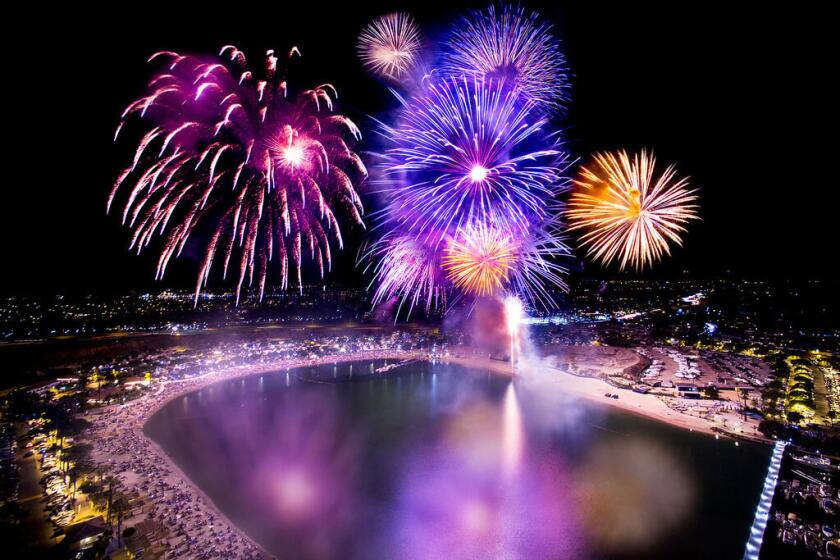Comments & Curiosities: A ‘cool’ way to travel
- Share via
Are you a musher? I’m not.
No, mushers are not people who play with their food. Mushers are those hearty souls who stand on the back of a snow sled in strong wind at minus-yikes degrees and somehow convince a team of really buff dogs to pull a heavy sled through the snow for hours on end. It’s an acquired skill.
Rancy Reyes is definitely a musher. As reported this week in this very publication, Rancy and his team of six Siberian huskies have been training hard, getting ready for the “American Dog Derby,” an annual dog sledding race that’s been run in Ashton, Idaho, since 1917. If you’re not familiar with Ashton, it’s about 20 miles north of Sugar City. But here’s the twist. Rancy and the pups haven’t been training in the frozen wilds of Alaska or the snow-covered foothills of the Rockies.
They’ve been training in Fairview Park in Costa Mesa and Newport’s Back Bay, which is just like the frozen wilds of Alaska only warmer and not as white. That’s why Rancy is called an “urban musher” — he and the boys do their mushing in the big city, not the big tundra. But the amazing thing is it works like a charm.
Rancy’s pooches were born to run, and he says he takes them to workout whenever he can in the honest-to-God white stuff in places like Mammoth Mountain. To say his team loves to run is an understatement.
“You try walking a husky, and your arm gets yanked out of the socket,” Reyes said in the Pilot’s story.
That sounds a little painful so I’m going to pass on that for now, but as any husky can tell you, except they can’t because dogs don’t actually talk, if you can pull a heavy sled up and down a dirt trail in Fairview Park, you can fly like the wind on packed snow in the Yukon. Whatever else dogsledding is, it isn’t new.
Native people like the Inuit in the far north have been tooling around on dog sleds for centuries. The Royal Canadian Mounted Police, also known as Cops with the Coolest Outfits, were using dog sleds to patrol the frozen forever land since the 1870s. The first organized dog sled race was the All Alaska Sweepstakes in 1908, a run of 408 miles from Nome to Candle and back. If you’re not familiar with Candle, it’s about 600 miles north of nowhere.
But the big boost for sled dogs was an amazing humanitarian effort in 1925, after a breakout of diphtheria in Nome. A major storm shut the city down, and there was no way in or out by road, rail or air. There was no diphtheria serum to be found and the Inuit people had never even been exposed to the disease, let alone had any resistance to it. Twenty-two dog teams with Inuit and post office mushers ran a 20-pound canister of antitoxin over hundreds of miles of frozen wilds to some very grateful Inuit in Nome.
A Norwegian musher named Gunnar Kaasen and his lead dog, Balto, arrived in Nome with the serum at 5:30 a.m. on Feb. 2, 1925. I don’t know why anyone would be traveling that early, but that’s just me. Gunnar Kaasen is long forgotten but Balto is large-and-in-charge in New York’s Central Park of all places, in the form of a larger-than-life bronze statue, where it has stood since 1925. I guess it’s true. It’s good to be the lead dog.
What is now the world’s most famous sled dog race, the Iditarod, has been run every March since 1973 to commemorate the 1925 “Mercy Run” from Anchorage to Nome. There was a time when I thought racing in the Iditarod would be the perfect “bucket list” adventure, but that was before I found out the race covers 1,161 miles, temperatures are minus-60 or below and you race day and night for 10 days. Worst bucket list item I’ve ever heard.
I think that’s it. if you’re lucky enough to catch sight of Rancy Reyes and his six exceedingly husky huskies in Fairview Park or around the Back Bay, smile, wave and most important, stay out of the way. A dog’s gotta do what a dog’s gotta do. Mush, dogs, mush. I gotta go.
PETER BUFFA is a former Costa Mesa mayor. His column runs Sundays. He may be reached at ptrb4@aol.com.



